Why is the bug bug dangerous on tomatoes: control measures for effective and quick disposal of the pest
All bugs are divided into two types: blood-sucking and plant-feeding. The former are harmful to health and dangerous for mammals and people. The second type causes significant harm to agriculture.
In this article we will figure out how to recognize pests and also consider effective measures to combat them.
Bug bug - phases of development and where it occurs
Main habitat: steppe zone, forest-steppe. The bug is widespread in the steppes of Ukraine, Russia, Bulgaria, Romania and Greece. Also found in North America and Asia.
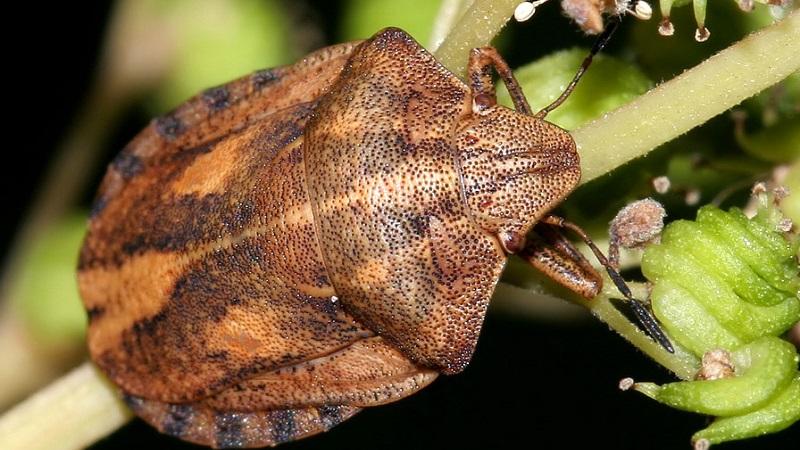
The insect leads a parasitic lifestyle on cereal crops, but can also feast on other types of plants. Although the vegetable garden is not its main habitat, the bug bug is also found on tomatoes, causing significant damage to the plant.
The life cycle of a harmful turtle lasts about twelve months. Only imagoes (adults) can survive the winter period. After awakening, their main task is to find a place to reproduce and live. The mating season begins in the spring. Having settled in the fields, the females begin laying eggs. This happens two weeks after moving from hibernation sites.
The egg development period lasts from one to three weeks. Its duration depends on the air temperature. Ripe eggs turn into larvae. Then, over the course of several months, an adult individual is formed from the larva.During this time, the larva goes through five stages of development, during which it feeds on milk shoots of wheat.
Adults overwinter in the forest, where they migrate after the autumn harvest.. In the spring, when the temperature reaches 15 degrees, the development cycle repeats.
Read also:
What does a pest bug look like?
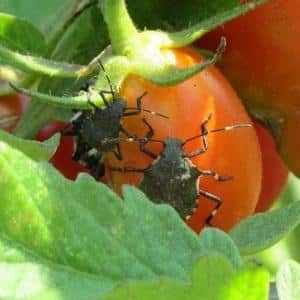 The adult specimen has a wide oval shape. The length ranges from 10-14 mm, width 6 mm. The color varies: from light brown to black. The insect's body is protected by a chitinous shell, framed by spots of different shapes and colors. Thanks to its specific color, it got its name - turtle.
The adult specimen has a wide oval shape. The length ranges from 10-14 mm, width 6 mm. The color varies: from light brown to black. The insect's body is protected by a chitinous shell, framed by spots of different shapes and colors. Thanks to its specific color, it got its name - turtle.
The insect belongs to the order Hemiptera and is capable of flight.. However, flying requires a lot of energy, so the bug prefers to crawl.
How harmful an insect is and how to detect it
The main damage the bug causes to grain crops. Living in fields with wheat, rye and barley, it destroys a large amount of crops. It does not matter at what stage of development the bug is. In the larval state, it damages young shoots, and in the adult stage it feeds on grain.
Digging into the grain, a mature bug secretes a special enzyme, due to which the structure of the grain changes. After the contents of the grain are transformed into a liquid state, the insect absorbs it. Therefore, you need to know how to deal with the pest.
Important. Even if the turtle bug did not eat the crop, but only released an enzyme into the grain, the product becomes unusable, since its gluten content is reduced.
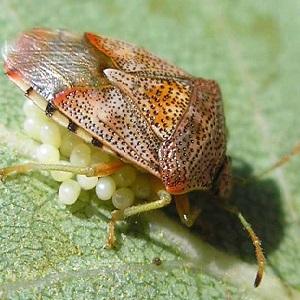 To identify the number of dangerous pests in the fields, check the plant at all stages of its growth:
To identify the number of dangerous pests in the fields, check the plant at all stages of its growth:
- the escape;
- bloom;
- milky ripeness;
- harvesting.
The most effective period for treating crops against bugs - milky ripeness.
Features of appearance and lifestyle
All bedbugs are similar to each other. The pest can be distinguished only in the adult stage of development. The edges of the bedbug's back and head have a rounded shape. In other species they are either concave or straight. Eggs and larvae are identical to other types of bedbugs.
Bedbugs overwinter in fallen leaves. Awakening occurs at a temperature of 14 degrees. Female insects lay eggs on the underside of the leaf in quantities of up to forty eggs.
Natural decline in the number of turtle bugs
There are a huge number of insects in the environment, helping to reduce the number of bedbugs. The most common:
- hemflies;
- telenomus;
- ants;
- centipedes;
- predatory mites.
The listed insects influence bedbugs at different phases of their development. Some destroy eggs (telenomus), while others parasitize directly on the insect and feed on it (egemfly).
All of them are indispensable assistants in the fight against pests., and a decrease in their population leads to the active reproduction and spread of turtle bugs.
How to overcome stink bug on tomatoes
The pest is extremely rare on garden crops., and when the bug parasitizes tomatoes in small quantities, the damage to the crop is unnoticeable. Most often, gardeners see no reason to worry.
But when tomatoes suddenly wilt, you need to know how to deal with the pest.. If stink bugs appear in large quantities in the garden, take immediate action.
Chemicals against pests
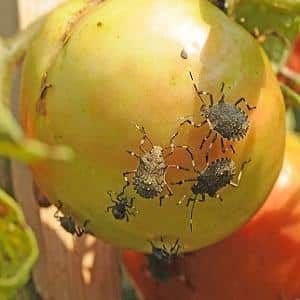 Basic chemicals for fighting stink bugs:
Basic chemicals for fighting stink bugs:
- "Aktara". An intestinal drug, after consuming the treated plant the bug will live no more than a day.
- "Karbofos". An intestinal poison that disrupts digestion and metabolic processes, and as a result, the insect dies.
- "Chlorophos". A pesticide, a toxic chemical, disrupts the transmission of impulses and suppresses the activity of parasites.
When performing any type of plant treatment, take into account weather conditions.. You should not schedule treatment if rain is in the forecast. Water will wash away the drugs and you will not be able to achieve the desired result.
Read also:
How is spraying boric acid beneficial for tomatoes?
Traditional methods
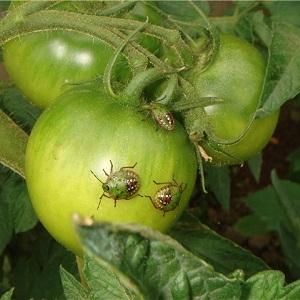 Spotted in the garden insect pests will disappear thanks to simple recipes:
Spotted in the garden insect pests will disappear thanks to simple recipes:
- Pour 400 g of onion peel into 6 liters of water heated to 100 degrees. Leave for seven days, then process the tomatoes.
- Dilute 200 g of dry mustard powder in 800 ml of water. Pour the resulting mixture into 10 liters of cool water and treat the young plant.
- Dilute 4 tsp garlic powder in 1000 ml water. Treat tomato leaves with the solution.
All traditional methods are designed to repel insects: they will not die, but they cannot harm the plant or destroy the crop.
Rules for processing tomatoes
Chemicals work well against pests, but they are toxic. Before you decide how and with what to process tomatoes, it is important to understand that only by strictly following the instructions on the packaging will you achieve results.
Important! The bug develops immunity over time. In the future, to destroy it, you will need a large dose of the chemical, which is harmful to the crop. Therefore, use different drugs.
How to get rid of a harmful bug quickly
The maximum effect in pest control is ensured by treatment in several stages. The first treatment is aimed at exterminating imagoes (adults) that have returned to the fields after hibernation. The second destroys larvae and eggs, and should coincide with the development of young ears.
Prevention of bedbugs
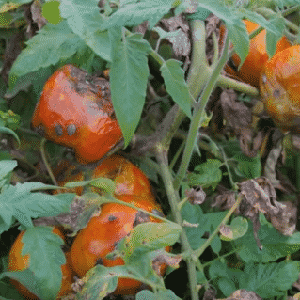 To prevent losses harvest and significant reproduction of bugs on tomatoes such preventive measures should be carried out:
To prevent losses harvest and significant reproduction of bugs on tomatoes such preventive measures should be carried out:
- enrich the soil with calcium and phosphorus;
- harvest in a timely manner;
- regularly treat areas from weeds;
- plant plants that repel pests, such as black cohosh;
- walk chickens in the garden, as they feed on bedbugs.
Conclusion
The pest bug is not the main enemy of tomatoes, but you should not let your guard down. If the number of natural enemies of this species decreases, the damage caused to the crop will be enormous. Particular attention should be paid to the number of pests on the site during hot, low-wind summers, which are favorable for the development of the bug.
If you notice insects in your area, immediately take preventive measures. They do not require large financial and energy costs, but are highly efficient.